
If there’s one nightmare that all character artists share, it’s drawing hands. Even if you’re a manga artist and you tend to simplify all body parts for stylization purposes, hands can’t really be simplified that much. After all, it’s not the details that make them difficult to draw—it’s their flexibility. They’re like a character of their own!
In this tutorial, I will show you how to draw anime hands by explaining the anatomy and structure behind them. I’ll show you how to simplify the rhythm of the hands, how to start the drawing, and how to keep the proportions correct. I’ll also show you how to draw the feet, which are another problematic issue for many artists. If you want to keep things simple, I’ll show you how to draw hands and feet step by step as well.
This is part three of our series, How to Draw Anime. If you’re interested in drawing manga in general, you may want to check these out, too:
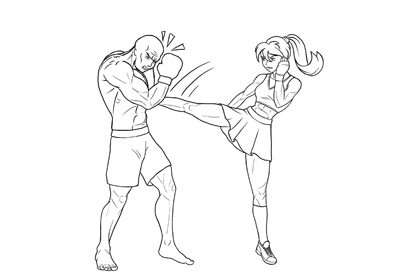 DrawingHow to Draw Anime CharactersMonika Zagrobelna
DrawingHow to Draw Anime CharactersMonika Zagrobelna DrawingHow to Draw Anime Heads and FacesMonika Zagrobelna
DrawingHow to Draw Anime Heads and FacesMonika Zagrobelna
1. The Anatomy of Anime Hands
Anime hands, though so smooth and simple, share their basic structure with real hands. If you understand this structure properly, everything will be easier for you! Let’s start with the bones.
As you can see, the fingers are longer than they appear. They’re “buried” inside the palm, which makes this part less flexible. That’s why for practical reasons it’s better to see fingers as starting where the palm ends. The thumb is an exception here—it’s far away from the rest and can move on its own, not being limited by the palm.
Each finger has three joints. The sections between them get progressively shorter. The thumb again is an exception—it only has two joints, and its bones are similar in length.

Of course, we don’t really need to know the bones—we need to know their function and how they affect the look of the hand. The simplified structure of the hand consists of:
- the heads of the forearm bones (in the shape of a wide wristband)
- the wrist (in the shape of an ellipsoid)
- the palm (in a complex shape that we will discuss in a moment)
- the thumb base (in the shape of an ellipsoid)
- four three-segmented fingers
- one two-segmented thumb
It’s very important to memorize this fan-shape rhythm between the joints. It influences the look of the hand, regardless of the pose of each finger. It makes it easier to guess the position of each joint in relation to the others, even the thumb’s.

But the surprising thing is that the fingers don’t really differ that much in length. If you remove the fan rhythm and place the phalanges (the finger bones) side by side, you won’t see that much of a difference. That’s why, instead of memorizing the length of each finger’s phalanges, you just need to remember the relation between them—the change in position as defined by the rhythm of a fan.

Proportions of Anime Hand
There are certain proportions that you need to know to draw a correct hand. You don’t need to be strict about them, but keep them in mind and try to follow them.
First, the length of the index finger is roughly equal to the whole palm (along with the wrist joint hidden in its base).

The ideal proportion of the joints on the index finger is: a half for the second joint, then again a half for the third. However, in reality, the second joint often lies at about 40% of the finger’s length. Feel free to chose the proportion that you like more—in stylized anime hands, the difference shouldn’t be that visible!
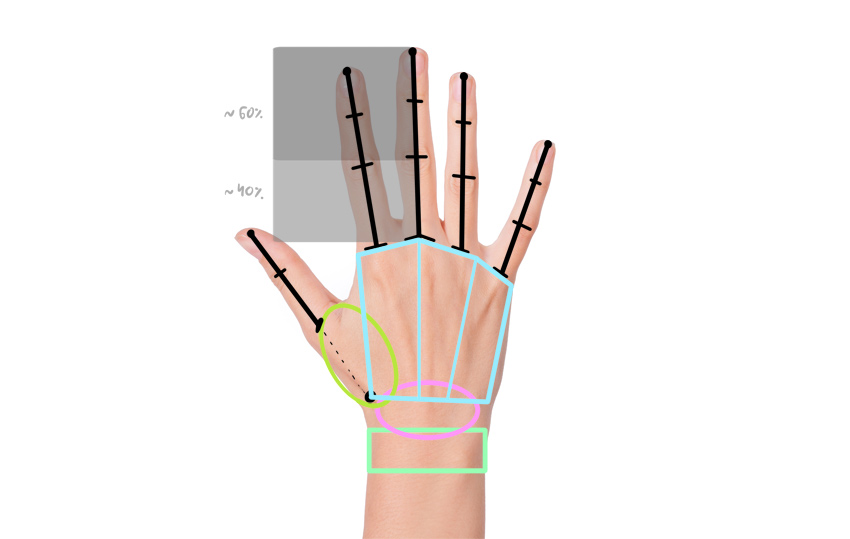

The thumb is as long as or slightly shorter than the little finger, but for me it’s best measured through its relation to the first finger—the thumb’s tip doesn’t reach its second joint.

2. How to Draw a Hand the Simple Way
But knowing the proportions of an anime hand is just one thing. How to start a drawing is another. Let’s simplify what you already know to learn how to draw a proportional hand from scratch.
Step 1
You can simplify the wrist to an oval and the palm to a bigger oval. When you draw it this way, you can easily rotate the hand at the wrist, imagining it as a ball.
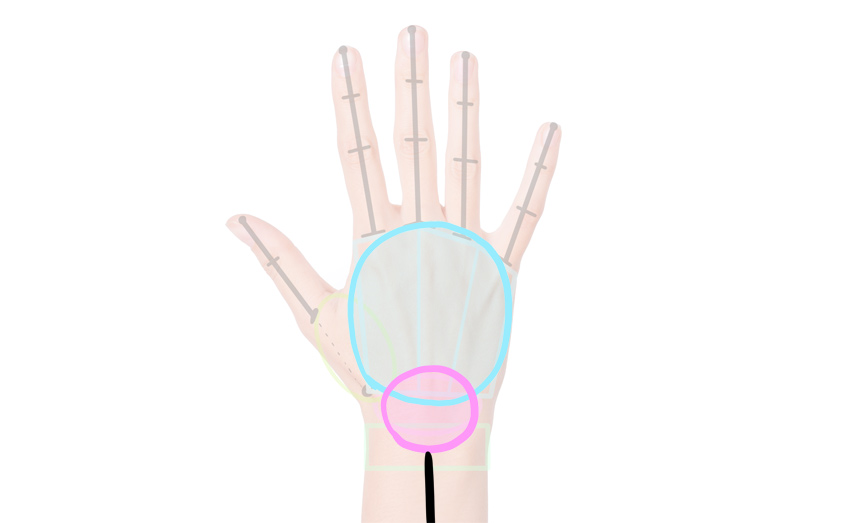
Step 2
Add an oval for the base of the thumb. To keep it proportional, make it slightly longer than half of the palm.

You need to remember that the thumb is not really a part of the palm, from a functional perspective. You need to imagine the whole hand three-dimensionally, not like a flat plane.

Step 3
The palm itself has an interesting form. Place your hand on a flat surface in a relaxed way. You’ll notice that only the little finger and the thumb rest on the surface, while the others hang in the air. The palm isn’t really flat, unless you spread the fingers on purpose.

So we have two problems here:
- The palm must be curved.
- The palm must have the fan rhythm on top.
These together create a very complex form—something hard to imagine, let alone draw! But there’s a solution to this problem. We can group the finger in two pairs and connect each pair to a separate ellipsoid—just like the one the thumb is attached to. If you make one pair smaller (ring finger, little finger) and put it lower, you’ll get the shape we need!

Still confused? Let’s draw it in 2D. First one, longer oval…

… then a second, shorter oval. They should both start in a similar place, and spread slightly to the sides like an asymmetrical heart.

Step 4
You should have no problems with applying the fan rhythm now, and the fingers just have to follow it.

Here’s the whole simplified structure of the hand for your reference.

Step 5
One more thing: the fan rhythm is not an accident. The fingers can go together, creating the shape of a mitten.

This flat mitten can be useful in some poses. Instead of drawing separate fingers, you can draw them together as one shape.

3. Details of the Hand
But proportions and shapes are not everything—without details, it’s just a skeletal hand. Let’s see what else we can add to our hands.
Details of the Palm
Hands are not only bones—they also have muscles and fat. These elements are mostly important on the palm side. Look at your own hand to locate these parts:
- Each phalanx has a fat cushion underneath. This makes the fingers look curved below (in contrast to the flat, bony top).
- All the fingers have a big cushion right on the base. It lies right under the big joint and covers a part of the first phalanx. Because of it, the fingers look shorter on the palm side, but just bend them to see where the bone really starts.
- There are two cushions on the sides of the palm—one for the thumb, and one for the little finger. Because of them, there appears to be a hollow in the center of the palm.
- Although the wrist bones seem to be buried inside the hand, there’s one bone that sticks out (pisiform). You can feel and see it under the little finger’s cushion.
- A similar bony protrusion can be felt on the other side. It’s the hand of the radius, the forearm bone. It sits slightly lower than the pisiform.

How to Draw Fingers
Let’s learn how to draw the shape of the fingers now.
Step 1
Draw a big circle at the base of the finger.

Step 2
Draw a smaller circle at the second joint. Connect it to the first one. These lines should taper a little. Also, if you draw the bottom of the phalanx, remember to add a curve.

Step 3
Drawn an even smaller circle at the last joint. Connect it to the previous one. This phalanx doesn’t have a lot of cushion, so the curve only appears if the finger is bent.

Step 4
Draw the tip of the finger in the shape of a smooth wedge. Avoid completely pointed tips, unless you’re drawing your character in a deformed style.

Step 5
Add the nails at the halfway point of the last phalanx. They should be very subtle—their outline can’t compete with the more important outline of the whole hand.
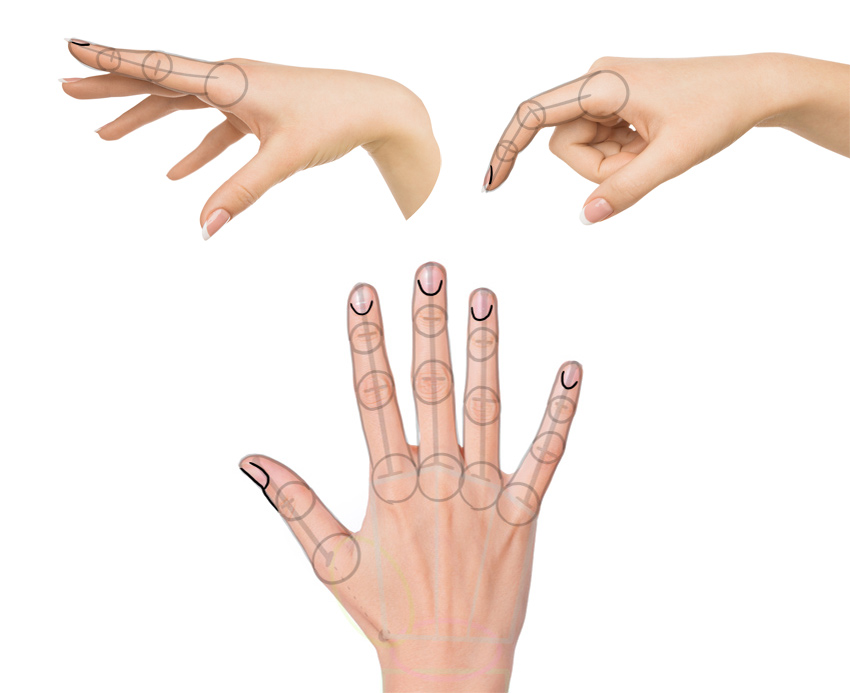
Step 6
Don’t forget about webbing between the fingers!
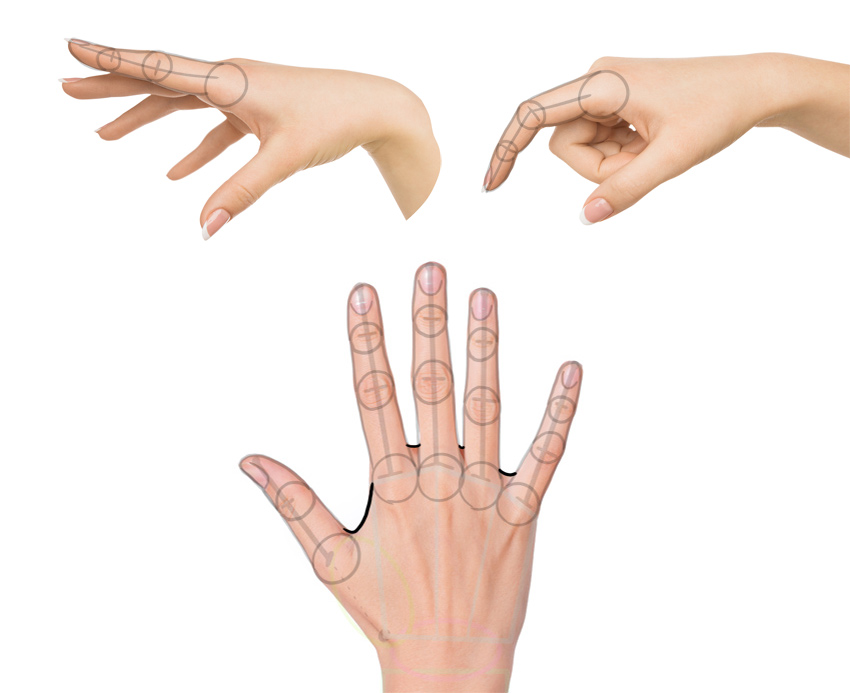
4. How to Draw Anime Hands Step by Step
Enough theory! Let’s see how to draw anime hands in every pose! For this exercise, it’s good to use a reference. In fact, to learn how to draw hands, you need to practice a lot—not from imagination and guessing, but by analysis of the real thing. This constant exposure to the structure of a real hand will help you develop an intuition, and you’ll start “feeling” the difference between a correct pose and an incorrect one.
Here I used this photo of various hand poses from Envato Elements.
Step 1
Start by drawing the basic rhythm of the hand. It doesn’t matter which finger you choose for this line of action—choose the one that seems to be the most important in the pose.

Step 2
Sketch the palm, for now only as a rounded box. Remember about its basic perspective, but ignore the curving and the fan rhythm for now.

Step 3
Add the base of the thumb. Adjust its length to the length of the palm.

Step 4
Add the oval base for the first finger and the index finger. It should tilt slightly towards the thumb, and it should be quite long.

Step 5
Add the base for the ring finger and the little finger. It should tilt away from the previous base. It should also be shorter and placed lower.

Step 6
Mark the fan rhythm to see where the finger should start.

Step 7
Sketch the rhythm of the fingers. Remember to use the proper length for each. You don’t have to measure anything—just make sure that the index finger looks similar in length to the palm with the wrist.

Step 8
Mark all the joints by copying the rhythm of the fan.

Step 9
Add the masses now. Notice how the cushions get squished in some poses.


Step 10
Draw the shape of the fingers now. It’s my favorite part because it’s when the hand starts looking like one!




Step 11
Add the “wristband” and the bony protrusions below the little finger.

Step 12
Add the webbing between the fingers and create an outline between the elements.

Step 13
Draw the final lines. Remember not to outline everything—the hands should be just as detailed as the rest of your character. Otherwise, they won’t look consistent.

5. The Anatomy of Anime Feet
Whew, that was intense! Luckily, feet are not as complex as hands. They’re built for stability, so they don’t change shape that much. But if you take a closer look at the bones, you’ll see the same ones as in the hand—which explains why in my language (Polish) and in many others, the toes are simply called fingers.

Structure of an Anime Foot
We can simplify the foot just as we did with the hand. The main difference here is that there’s a huge bone in the back, the heel, which acts like the pisiform in the hand. Also, the “fingers” are much shorter than the “palm” here.

Proportions of an Anime Foot
It’s quite easy to make a foot look proportional. The whole foot is about four big toes long. The “palm” is less than two big toes long. The other toes share the fan rhythm you’re already familiar with. Notice that the big toe, just like the thumb, has only two joints!

The Sole of the Foot
There are also important details on the bottom side of the foot:
- Each toe has a big cushion under the last phalanx.
- There’s a big cushion under the base of the toe.
- There’s a big cushion under the heel.
- The foot doesn’t touch the ground on its whole surface—only this orange curved area does.

6. How to Draw Anime Feet in Perspective
Let’s take a closer look at the 3D forms building the feet.
Step 1
Most of the foot can be simplified to little rounded “shoes”, or a water balloon. This form includes both the heel and the rounding on top of the foot. We can draw it this way, because this area doesn’t really change shape that much.

Step 2
The problem is that the foot isn’t uniformly flat on top. Just like the hand, it curves downwards towards the smallest toe. So after you draw this big shoe-shape, you need to flatten one of its sides. Take a look at your own feet to understand it better.

Step 3
The first joint of each toe starts here. This is also where the fan rhythm appears for the first time.

Step 4
This is where the longest phalanges start. They have a very simple, blocky shape.

Step 5
It’s good to draw the last phalanges at once after this. Why? Because the cushions under them reach back a little, landing right under the middle phalanx, which, as you’ll learn next, has a curious shape.

Step 6
The middle phalanx drops down towards the last one. The smaller the toe, the more visible the angle.

Step 7
Although manga style ignores many details, sometimes you may want to add the ankle bones, too. They’re visible on the sides of the ankle, but they’re asymmetrical—higher on the inner side.

Step 8
While outlining the forms, remember to create an indentation on the inner side of the foot. If you don’t know why it’s necessary, go back to the part where we were analyzing the sole of the foot—or simply take a look at your own!

Step 9
Knowing all of this, you can simplify any foot to a set of basic lines that are perfect to start a drawing:

7. How to Draw Anime Feet Step by Step
This theory is all you need to start drawing! As earlier, we still need some references to learn how to create believable poses. I used this photo of feet in various views.
Step 1
Start with a basic rhythm of the foot. Ignore the heel for now.

Step 2
Add the heel now, just like a simple line at a fixed angle.

Step 3
Add the ankle area as a simple sphere.

Step 4
Add the “shoes”/”water balloons” under the ankle. You should see it clearly on the reference photo.

Step 5
Mark the top of the foot, along with its tilted side.


Step 6
Add the first row of toe joints. Make them big and round. It’s not always necessary to draw all of them if they’re obscured by each other.

Step 7
You can go two ways now: draw the last phalanges along with the cushion, or draw the middle one with this trick:


Step 8
The last phalanx is quite easy to draw! Just follow the rhythm.

Step 9
Don’t forget the details of the sole.

Step 10
Add the “wristband” of the ankle to connect the foot to the rest of the leg.

Step 11
Outline the foot, keeping only as many details as you need.
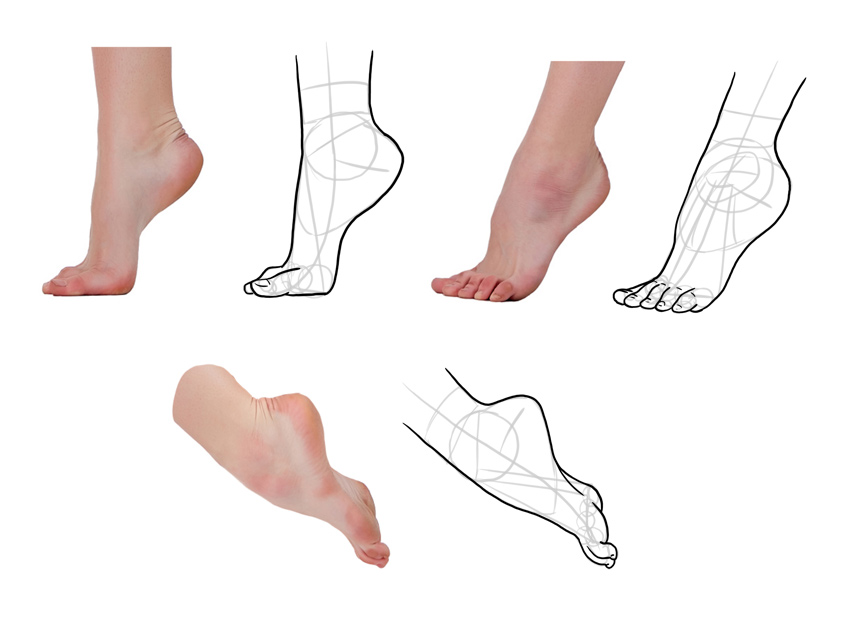
Well, That Was Handy!
Now you know how to draw anime hands and feet! Remember, even if it looks difficult now, with regular practice it will become second nature. And your characters won’t have to hide their hands or feet anymore! If you want to practice on the same photos I used in this tutorial, here’s a list of them:
- Foot in a side view
- Feet in various views and poses
- The soles of the feet
- An RTG photo of a hand
- “Open” hands
- “Closed” hands
- Top view of a hand
- Bottom view of a hand
- A set of hands in various views and poses
If you like stylized drawing like manga, you may also be interested in our series How to Draw like Disney:
 DrawingHow to Draw Disney CharactersMonika Zagrobelna
DrawingHow to Draw Disney CharactersMonika Zagrobelna DrawingHow to Draw Disney AnimalsMonika Zagrobelna
DrawingHow to Draw Disney AnimalsMonika Zagrobelna Fan ArtHow to Draw Disney VillainsMonika Zagrobelna
Fan ArtHow to Draw Disney VillainsMonika Zagrobelna
And if you liked the deconstruction-based format of this tutorial, you may also like my series on how to draw the parts of the face:
 Human AnatomyHow to Draw Lips and a MouthMonika Zagrobelna
Human AnatomyHow to Draw Lips and a MouthMonika Zagrobelna DrawingHow to Draw a NoseMonika Zagrobelna
DrawingHow to Draw a NoseMonika Zagrobelna DrawingHow to Draw EarsMonika Zagrobelna
DrawingHow to Draw EarsMonika Zagrobelna

{excerpt}
Read More